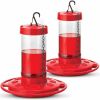
What’s This Post About?
Looking around at the numerous species of birds out there, you see ones that are drab brownish, some with hues of gray and green while others that are conspicuously bright and colorful in tones of orange to red and pink.
Amidst all these birds, you’ll find relatively small yet noticeable birds fluttering around in radiantly bright, glittering plumage. If you’re wondering what these gorgeous dainty species blazing around are, you rightly guessed it. They are the hummingbirds, who effortlessly add an ornamental touch to your environment.
Hummingbirds don’t change colors. With each slight flit of the bird, it appears that the colors are changing but it is just the iridescent plumage and the rays of light falling on the birds at different angles that determines the color we see, making it appear shifting spectacularly.

Do Hummingbirds Change Colors?
Quite precisely, there is no distinct mechanism in the Hummingbirds that causes them to change colors, but it is a deceptive illusion that exhibits the bird’s stunning colors. The only time the bird changes the color of its feathers is when it’s transitioning in adulthood.
Why are Hummingbirds so colorful? Do the birds keep changing colors? What is the distinct mechanism of the birds that causes them to exhibit such spectacular, constantly changing shades of coloration? A plethora of questions arise in the minds of new and avid birders when observing the dainty little birds.
Like all the other birds, the young hummingbirds also go through the process of fledging as they get rid of their immature plumage and evolve to take on features of adult hummingbirds.
This development is the only time they experience an actual change in the color of the plumage. Once the bird has fully transformed into an adult and has fledged its adult plumage, there are no more transitioning of colors on the feathers.

The appearance of the bird stays constant for the rest of its adulthood. As they fly about and perch around, it is their iridescent plumage that creates the illusion of altering colors.
Then what is it that causes color variations in the colors of its feathers? In reality, it is not the color but the angle of the light that hits the feathers that lets you see different colors of the spectrum on the bird’s feathers.
Fun Fact
Relative to their size, the hummingbirds have a higher ratio of feathers on their bodies in comparison to the other birds around - estimated to be around 900 feathers!
Colorful Plumage of The Hummingbirds – The Science Behind The Illusion of Shifting Colors
The dynamic color change of the stunning species is merely nothing more than a pretty illusion, playing around with the rays of light.
To get a better understanding of this phenomenon let’s delve into a bit of science that explains how the bird appears to pull off this spectacular color change.
We know that the light rays coming directly from the sun are spread over a broad spectrum - as Physics explains. These wavelengths of light interact differently with the surrounding objects, determining the colors that we’re able to see.
In the case of hummingbirds, the peculiar structure of the birds fully incorporates the concepts of wavelengths and light rays to give an impression of incessant color change.

The feathers of the hummingbirds are not pigments, but structural colors that give the mesmerizing iridescence on the feathers. In hummingbirds, the surface of the feathers comprises air bubbles.
When the light hits the surface, it doesn’t stay there, but rather reflects and refracts at varying intensities. Some wavelengths of light can pass through one layer of the bubble surface while others can travel underneath.
The light rays traveling in different directions are what results in the beautiful illusion, appearing to change colors. Each slight movement of the bird changes the angle of the light reaching the air bubbles. We, humans, see the rapidly changing colors as a delusion.

Let’s get a better understanding of this concept using some quite common examples.
-
Consider a puddle of water on the ground layered with some oil. If you throw a pebble on this puddle, you’ll observe a change in shape and see various shades of colors running through the layer of oil. What this illusion of color comes down to is simply the angle of light changing.
-
In the same way, the vast ocean appears to comprise an array of tones of blue, reflecting the blue sky as different wavelengths reflect at the water with varying intensities.
5 Stunning Species of Hummingbirds with Iridescent Feathers
If you’ve ever taken a close look at these dazzling birds, you know how their colors appear to change in split seconds. Let’s see how the pigment-containing structure of the bird results in a reflection of hues of tints with each sassy movement of the head and plumage.
| Name | Scientific Name | Size |
|---|---|---|
| Anna’s Hummingbird | Calypte Anna | 4 inches |
| Ruby-throated hummingbird | Archilochus colubris | 2.8 to 3.5 inches |
| Costa’s Hummingbird | Calypte costae | 3-3.5 inches |
| Rufous Hummingbird | Selasphorus rufus | 2.8 to 3.5 inches |
| Allan’s Hummingbird | Selasphorus sasi | 3-3.5 inches |
1. Anna’s Hummingbird

The Anna’s Hummingbird constantly appears to sport spectacular hues of color, though it’s merely the mechanism of light waves being absorbed and reflected at different angles.
The distinctive crimson red crown on Anna’s head and its gorgeous green feathery plumage look mesmerizing in bright light, but as soon as the angle of light changes a little, the rich blend of colors appears as dull brown or grey.
Fun Fact
Anna's hummingbirds have the fastest rate of shaking their body among all the vertebrates. During flight, the flashy bird can shake its body 55 times per second!
2. Ruby-throated Hummingbird

A ruby-throated hummingbird has an iridescent red throat that sometimes appears to be brightly orange. As a fact, we know that the dazzling birds have red throats, and it’s simply the interaction of light with its iridescent feathers that causes the light to refract and reflect at different intensities that brings out the orangish tones.
3. Costa’s Hummingbird

The head and gorget of the Costa Hummingbird are magnificent deep purplish to violet while it has a green back. With changes in light, the bird flamboyantly flashes its violet color changing to hues of gorgeous blue to dark green and bronze-green.
4. Rufous Hummingbird

The gorgeous bird resembles in tones to brightly glowing coals with a burnished rusty orange plumage. The breathtakingly radiant deep orange-red throat of the bird cannot be overlooked.
With just the right intensity of light striking the bird, its iridescent feathers on the head scintillate tones of golden-green to bold oranges.
5. Allen’s Hummingbird

The tiny spectacular bird is beautifully crafted with cinnamon sides and a coppery orange tail. It also has a rump, a bronze-green head, back, and wings.
Flashing around its brilliant fiery orange cheeks and iridescent throat that alternates between hues of orange and bold red as the little bird flits its face, the light bouncing off its feathers gives the gorget a sparkling touch.
If you watch a hummingbird closely perching on a nearby tree, observe it switching its vibrant jewel tones rapidly as it flicks around in less than a minute.
Depending on the angle of light you’re taking a look from, see how slight flits change its yellowish-green feathers to dark green and then to brilliant hot pink, and further flits reveal a shining golden green that the bird conspicuously flashes around.
Arranging a Color Show In Your Backyard
Do not miss out on any chance to fill your backyard with hues of vibrant colors by inviting these tiny jewel species as they put on an eye-catching show. Spring is the right time to attract tiny hummers to your yard.
Get the right feeder for the birds, and fill it with the juiciest of nectar to enjoy regular visits from the bird. You can purchase the SEWANTA Hummingbird Feeders for Outdoors to make this happen.
SEWANTA Hummingbird Feeders for Outdoors
BIRD FEEDER Kit - Includes [2] hummingbird nectar feeders for outdoors - Holds up to 16 oz of nectar - Round shaped With 10 feeding ports to satisfy multiple hungry hummingbirds at once - Tray style circular perch lets birds feed from all angles - Bundled With [2] adjustable rust-resistant hanging chains - 9.5 inches.
Hummingbirds Flashing Around
For us, the sparking change of colors is apparent magic, not a variation in the colors of the feathers. But to the Hummingbird, it is oblivious of the mesmerizing changes happening to its body appearance with each flutter.
Had it been aware, the gorgeous bird would leave no opportunity to flamboyantly flaunt itself!
Quite a typical trend in most bird species, the male has a much brighter and striking appearance with prominent features than the female. It doesn’t let go of any chance to attract a female mate by flashing its charming jewel colors.
The females, on the other hand, have a rather subtle appearance. You wouldn’t be quite appalled to stop by and enjoy the view. Lacking any flamboyant features unlike its male, it has paler feathers, usually greenish-brown in color.
Did You Know?
The dainty bird not only uses its magnificent jewel tones to entice females for courtship but also exhibits its dominance, deterring away other male birds around using its bold shades.
Exposing its iridescent gorget in bright sunlight reveals its glorious colors due to the bending of light rays. This refraction helps the birds buzz around displaying the glistening hues of colors on its body sporting the stunning reds, oranges, pinks, violets, greens, and blues.
With their gorgeous iridescent feathers, hummingbirds give us a gorgeous show of colors that you wouldn’t want to miss out on! If you plan your birding trip on a bright sunny day, there is a greater likelihood that you’ll be enthralled by the beautiful vibrant colors of the bird.
Your experience wouldn’t be the same on a dull, cloudy day, or as the sunlight gradually sets.
Keep Reading!
Through this post, we’ve learned that the apparent magic of colors in hummingbirds is caused by the scientific phenomenon of reflection and refraction of lights, and the birds do not change the color of the feathers every split second.
To find out more about where you should place your hummingbird feeder for the best results to attract these beautiful species, read our post.
Sun or Shade? Somewhere In Between? Hang Your Hummingbird Feeder for Best Results!
Where should hummingbird feeders be placed, in sun or shade? It is better to place them in the shade to protect them from the environment.

By David A. Swanson
Bird Watching USA
My name is David and I'm the the founder of Bird Watching USA! I started Bird Watching with My father-in-law many years ago, and I've become an addict to watching these beautiful creatures. I've learnt so much over about bird watching over the years that I want to share with the world everything I know about them!

David A. Swanson
Bird Watching USA
My name is David and I'm the the founder of Bird Watching USA! I started Bird Watching with My father-in-law many years ago, and I've become an addict to watching these beautiful creatures. I've learnt so much over about bird watching over the years that I want to share with the world everything I know about them!




